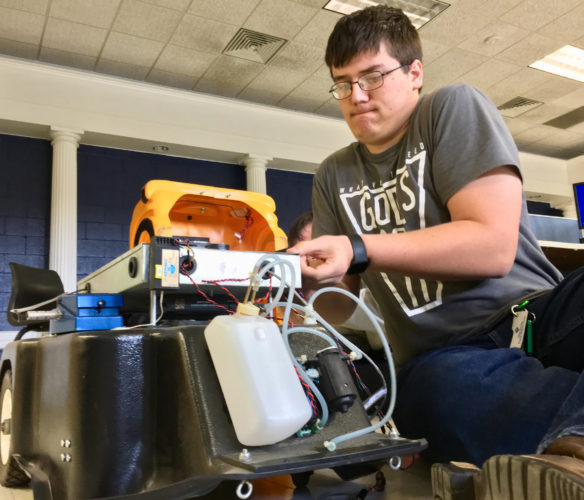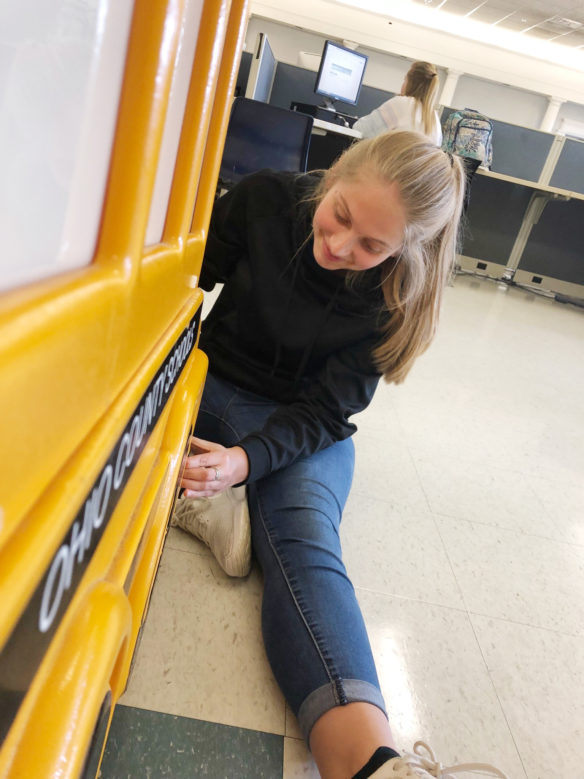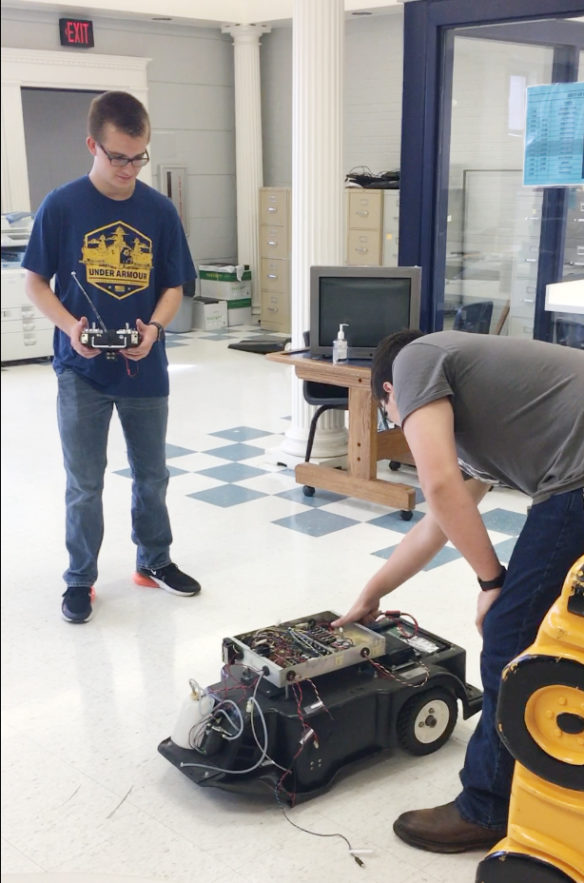
Bryan Grant, a student of Brian Barrett at Ohio County High School, cleans contacts and checks fuses in the computer that run Buster the School Bus. Several of Barrett’s classes used the broken remote-controlled robot to get a hands-on lesson about how to repair aging technology.
Submitted photo by the Ohio County High School yearbook staff
- Ohio County High School robotics instructor Brian Barrett used a broken Buster the School Bus to give his students a hands-on project in fixing old technology.
- The students produced a working Buster without exchanging any parts except the batteries, salvaging every mechanism in some way.
By Donna Melton
donna.melton@education.ky.gov
Ohio County began January with another bright yellow bus in the district transportation garage thanks to the efforts of a high school robotics class. But this refurbished school bus is not like all the others; it’s a 3-foot long, eyelash-blinking, talking miniature bus named Buster.
In 1995, the Kentucky Department of Education (KDE) purchased and distributed 15 Buster the School Buses throughout the state. Additional buses were added through 2002, and a fleet of 25 remain today.
The convoy of remote-controlled Busters taught students about school bus safety through song and demonstrations. Before Ohio County’s Buster lost its voice and broke a stop arm, it traveled to schools, community events and even the Kentucky State Fair.
The repair project began when Tom Woods, Ohio County schools transportation director, offered to assist KDE with refurbishing a Buster. Woods shared the idea with Ohio County High School robotics instructor Brian Barrett, who agreed it presented a unique learning opportunity for his students.
Barrett and his students from robotics, computer graphics and word processing classes transformed their classroom into a garage for some real-world learning to rebuild Buster. The students developed a project outline and evaluated the logistical problems to be solved so the 20-year-old bus could get back on the road.
Barrett immediately sensed his students’ interest when the custodians carried Buster into the back of the classroom. He asked his students if they would be on board with a special project that required technology and advanced robotics.
“The kids glanced back and forth at each other and a few of them laughed,” Barrett said. “But when they took a closer look at the circuitry, wiring and missing pieces, it led to questions that started them digging into a reconstruction journey.”
The connection to the robotics class was immediate as the students applied just-learned terminology to describe the reconstruction of Buster. They researched the mechanics of robotic motors from the 1980s. Since the $5,600 purchase of the first Buster, many original parts have become obsolete, so students received a history lesson on the evolution of electronics.

Winter Smith, a student at Ohio County High School, gives the district’s aging Buster the School Bus a face-lift with new stripe. Students in several of Brian Barrett’s classes used the district’s broken Buster to get hands-on experience in advanced robotics and technology. As the news of the bus rebuild has grown, two more broken Busters have been added to the classroom inventory for Barrett and his students to repair.
Submitted photo by the Ohio County High School yearbook staff
For six weeks in the fall, students studied steering, transportation, tire consumption and the expense of restoring the bus to its original capacity. They began by dismantling the shell of the bus and unwiring the handmade computer. Students discussed possible solutions to making parts work as they struggled to get the controller running.
“Sometimes the best lesson learned is that not everything needs to be demolished to be restored,” Barrett said “The students deliberated and discussed possible way of fixing the old technology instead of throwing it aside and trying something new. They cleaned contacts and replaced fuses. They evaluated their solutions.”
Barrett said the students dismantled the fiberglass shell of the bus three or four times to find out which repairs worked and which didn’t.
As the project grew, students used their computer graphics, mathematics and word processing skills to complete the project. The computer graphics students tested the communications system and adjusted the headphones. Word processing students assisted with reattaching parts and adjusting the service arms on the bus. Robotics students worked with Buster’s batteries and voltage.
When Buster was rebuilt, the students produced a working bus without exchanging any parts except the batteries. Every mechanism was salvaged in some way, so that not even a resistor was replaced.
Barrett described the Buster project as real-world learning from a one-of-a-kind piece of historic technology.
“One of the biggest challenges was making sure the students continued to take thorough notes,” he said. “Once a part of the bus was disassembled, there was no blueprint or schematic to reassemble it.”
Barrett said robots like the bus are used to communicate in entertainment, educational and even emergency settings.
“I know similar devices have reportedly communicated with trapped miners and in hostage situations, or maybe even with others in isolation or quarantine,” he said. “Any time we expose students to a new experience, it creates a learning experience that may help them adapt in the future.”

Tyler Johnson, left, works Buster the School Bus’ remote control as Bryan Grant hits the power switch to see if they have helped bring the district’s broken Buster back to life. Brian Barrett, who teaches both of the students, says the projects he creates for his students are practical lessons that provide them with opportunities to be aware of community needs. Buster will be used in the district once again to help teach young students about bus safety.
Submitted photo by the Ohio County High School yearbook staff
Barrett, a 24-year-teaching veteran, started teaching at a time when the curriculum was shifting from industrial arts to modular technology. He and his students have learned together as they explore various types of technology.
“As a teacher, I should never stop learning. Students need practical projects that connect them to what they see and touch, and how they learn,” Barrett said. “I have changed as our students’ needs have changed. I have always tried to resist that urge to look for an expected answer. We must be open to other acceptable solutions to problems so that our students will too.”
Barrett describes the projects he creates for his students as practical lessons that provide them with opportunities to be aware of community needs. Barrett’s students work on everything from electronic boards for companies to slideshows for retiring teacher. His students formulate plans, communicate with the client and then make the tough decisions about fiscal responsibility.
“Eventually what every business or company or client wants to know is, ‘Is it worth it?’” Barrett said. “That’s when my students see how an actual real-world problem progresses to a solution.
“None of us dreamed that Buster would take off working. We worked with technology that is now obsolete, but that is what must happen sometimes. We must destruct and reconstruct in order to make a project successful.”
As the news of the bus rebuild has grown, two more broken Busters have been added to the classroom inventory for Barrett and his students to repair.
Barrett described the moment when his students knew they had made a difference.
“The preschool kids who are in the family and consumer sciences area in our building saw this cartoon-like bus trucking down the hallway and their faces lit up,” he said. “When I turned to look at my students, their faces were smiling too.”
MORE INFO …
Brian Barrett brian.barrett@ohio.kyschools.us



Leave A Comment